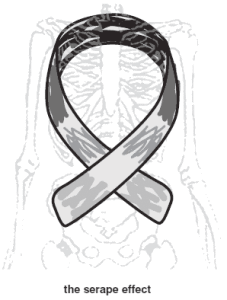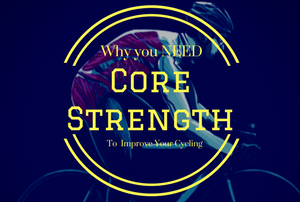Core strength is something that most cyclists know about, but don't tend to train very often. Even if they do train core strength and stability during the off-season (or the “not so off season” as I call it) they tend to ignore it again once the weather turns nice and on-bike training begins in earnest.
That mistake could not be more damaging to your season long cycling progression.
As you'll learn in this podcast, the core of your body is one of the most important parts of your power production on the bike. A weak core can lead to a variety of problems from neck and low back pain to loss of power, fatigue on long rides and unrealized power. So click through and start learning about what your core is, why core strength is so important and how you can build core strength with a free preview download of my upcoming Unbreakable Core Stability training plan.
Don't forget to like and share with your friends and help them build their core fitness and strength too!
 Show Notes:
Show Notes:
The sponsor for this episode of the Tailwind Coaching Podcast is Onnit – Total Human Optimization. Check them out for all the equipment you'll need to build unbreakable core strength as well as a ton of great training tools that I use myself!
In the next week or so, I'll be launching my Unbreakable Core Stability module.
- Designed for use throughout the season
- Specifically targets the underused deep core stabilizers (which you'll learn about in this episode)
- Can be performed almost completely without equipment (some exercises require Stability Bands or Kettlebells)
- Subscribe to the Tailwind Coaching Newsletter to get first dibs when it goes on sale, AND get a discount on it as well!
Battenkill training plan: to be released around Thanksgiving, with newsletter subscribers getting a nice discount on that as well.
Sometime around the first of the year, I'll be launching my “Executive Coaching Service” which will be a month-to-month coaching membership. You'll get a significant discount on training plans and be able to get coaching access for everything from strength training coaching to nutritional coaching to general fitness and cycling coaching. More to come on that.
@10:35 – What is the core and what is core strength:
- The Core basically redistributes and redirects forces in the body (The two Rs)
- TVA, mutlifidus, pelvic floor comprise the “core”
- The core is Neurologically linked together (EMG study – http://www.ncbi.nlm.nih.gov/pubmed/12054180)
- The core is a stability sling system that helps to stabilize your spine during transverse, frontal and/or sagittal plane movements.
Why is core strength important?
- The Redistribute part of the core pertains to this
- A strong core prevents back pain and hip pain – when the core is weak or non-functional, the spinal muscles take over as the stabilizers (QL, paraspinals, etc.) They're big muscles that are designed to move your body, not stabilize it. The more they are used for stability, the more they will tighten and spasm, and by default, hurt.
- A strong core leads to decreased neck pain and upper body/shoulder pain due to the “no muscle acts alone” concept: when one muscle pulls, it will affect the fascia surrounding it and pull through other muscles. Weak core strength will pull on spinal muscles that run up towards the neck and head, and may cause you to try and stabilize through the neck or shoulders (by shrugging the shoulders or tightening/extending the neck.) It will also put a lot of pressure on the hands and arms, causing issues with hand tingling/numbness and hand/arm/shoulder pain. (Basically, your body can't hold itself up enough.)
The core as a power transfer medium:
 This is where the redirect part comes into play:
This is where the redirect part comes into play:
- The core is base for legs to push from – a weak core means lost power in the leg muscles because there's no stable base to push against.
- The serape effect comes into play. The serape effect is a rubber band like effect that involves transfer of forces through the core. R>L Internal oblique/external oblique/serratus anterior/rhomboid/midline/reverse.
- Forces put through one side transfer over to the other side. Follow the sling down into the quad, tib anterior, around the sitrrup of the foot, into the peroneals/calf, hamstring, glute, lower back (both sides) and into shoulder girdle through the lats.
- This is why pulling on the bars adds force to your pedal stroke.
- So when one leg pushes down on the pedals, the other leg is wound up with potential energy through this sling, allowing for increased power (and it's why sprinters pull on the bars, HARD!)
- A stable core is absolutely necessary to transfer force between legs: imagine any other sport with “leg power” such as baseball. Force created through the legs and transferred to the point of contact with the core (point of contact being the arms in baseball). Weak core causes force loss when translating through. Same is true for cycling (force lost from leg to leg through weak core.)
@25:31 – How to build core strength:
- Think of core strength as the ability to redistribute or redirect forces: this means you have to train multiple planes of movement.
- Anti-extension movements: meant to prevent the spine from extending (or bending back). These help to avoid excessive pressure on the posterior spinal joints (the facet joints specifically) and prevents the low back from engaging and trying to stabilize the spine (instead of working in the posterior chain as it should.) Prevents one major source of back pain and tightness for most cyclists and the most common “core work” that is addressed in most programs.
- Anti-flexion movements: meant to prevent the spine from flexing (bending forward). These help to avoid excessive pressure on the spinal discs and rounding out the back. Exercises prevent over-dominance of the hip flexors and rectus abdominus (6 pack muscles, linked together with hip flexors) which will lead to a posterior tilt and excessive spinal flexion. Also note that flexion/rotation is a big component in disc injury and spinal injury.
- Anti-rotation movements (also includes anti-lateral bending movements): designed to prevent increased torsional pressure on the spine (when combined with flexion or extension can cause significant spinal injury). Important in stabilizing the spine during unilateral (one legged) motions/movements (hint hint, cycling IS A UNILATERAL MOVEMENT!)
For a great way to build core strength and stability, download the preview of my “Unbreakable Core Stability” module by subscribing to the email list or by liking/sharing.
Subscribe to the Tailwind Coaching Newsletter to unlock your free content and get my exclusive coaching tips, fitness advice and exclusive discounts in your inbox!
I'm getting VERY close to releasing the Unbreakable Core Stability module! Don't forget that my email list members will get first dibs at a discount, so sign up for the Tailwind Coaching Newsletter to get my best coaching tips delivered to your inbox, along with a free bonus training plan, updates, and exclusive discounts like the Unbreakable Core Stability discount!
If you enjoyed this episode, please do me a favor and head over to the Tailwind Coaching Podcast on iTunes and rate it 5 stars. A positive review helps the podcast move up the ratings, reach more listeners, and help more people get stronger, faster and fitter. Don't forget to post any questions to the Tailwind Coaching Facebook page, on the Tailwind Coaching forums, contact me via email or leave a comment below. Don't forget to support our sponsors and help to keep this podcast free, help me to get this information to more people and help grow the cycling community.
With the northern hemisphere's cycling season winding down, you can think about riding cyclocross or settle in and start building strength for the upcoming season. If you're in the market for a complete training solution, you can pick up your training plans by checking out my modular training plans in my online store. Let me help you build towards your best ever season with my season long training solutions and modular plans!


